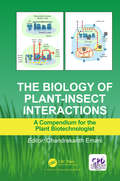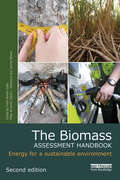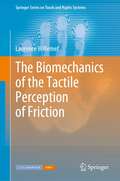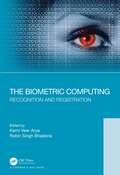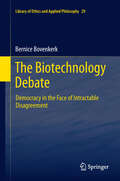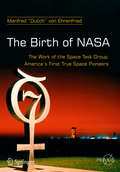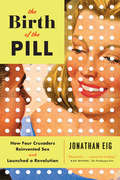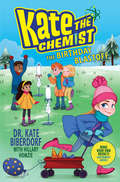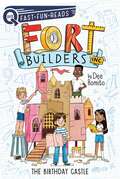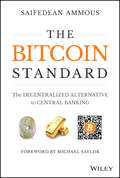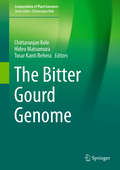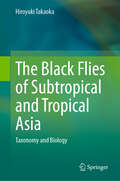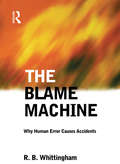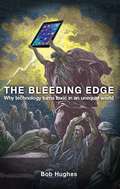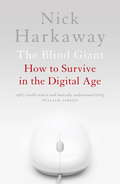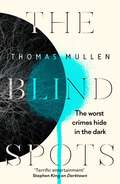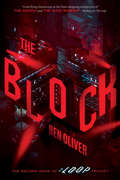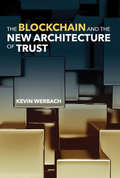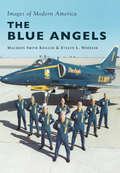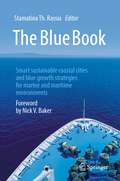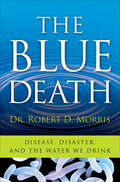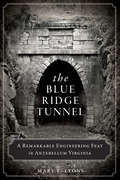- Table View
- List View
The Biology of Plant-Insect Interactions: A Compendium for the Plant Biotechnologist
by Chandrakanth EmaniOverviews of biochemical, genetic, and molecular perspectives of plant-insect interactions with added emphasis on bioinformatic, genomic, and transcriptome analysis are comprehensively treated in this book. It presents the agro-ecological and evolutionary aspects of plant-insect interactions with an exclusive focus on the climate change effect on the resetting of plant-insect interactions. A valuable resource for biotechnologists, entomologists, agricultural scientists, and policymakers, the book includes theoretical aspects as a base toward real-world applications of holistic integrated pest management in agro-ecosystems.
The Biomarker Guide
by J. M. Moldowan K. E. Peters C. C. WaltersBiomarkers are compounds found in crude oil with structures inherited from once-living organisms. They persist in oil spills, refinery products and archaeological artifacts, and can be used to identify the origin, geological age and environmental conditions prevalent during their formation and alteration. These two volumes will be an invaluable resource for geologists, petroleum geochemists, biogeochemists, environmental and forensic scientists, natural product chemists and archaeologists. The first of two volumes of The Biomarker Guide discusses the origins of biomarkers and introduces basic chemical principles relevant to their study. It goes on to discuss analytical techniques, and the applications of biomarkers in environmental and archaeological problems.
The Biomarker Guide: Biomarkers and Isotopes in the Environment and Human History
by J. M. Moldowan K. E. Peters C. C. WaltersBiomarkers are compounds found in crude oil with structures inherited from once-living organisms. They persist in oil spills, refinery products and archaeological artifacts, and can be used to identify the origin, geological age and environmental conditions prevalent during their formation and alteration. These two volumes will be an invaluable resource for geologists, petroleum geochemists, biogeochemists, environmental and forensic scientists, natural product chemists and archaeologists. The first of two volumes of The Biomarker Guide discusses the origins of biomarkers and introduces basic chemical principles relevant to their study. It goes on to discuss analytical techniques, and the applications of biomarkers in environmental and archaeological problems.
The Biomass Assessment Handbook: Energy for a sustainable environment
by Peter De Groot Frank Rosillo-Calle Sarah L. Hemstock Jeremy WoodsThe increasing importance of biomass as a renewable energy source has led to an acute need for reliable and detailed information on its assessment, consumption and supply. Responding to this need, and overcoming the lack of standardised measurement and accounting procedures, this best-selling handbook provides the reader with the skills to understand the biomass resource base, the tools to assess the resource, and explores the pros and cons of exploitation. This new edition has been fully updated and revised with new chapters on sustainability methodologies. Topics covered include assessment methods for woody and herbaceous biomass, biomass supply and consumption, land use change, remote sensing techniques, food security, sustainability and certification as well as vital policy issues. The book includes international case studies on techniques from measuring tree volume to transporting biomass, which help to illustrate step-by-step methods. Technical appendices offer a glossary of terms, energy units and other valuable resource data.
The Biomechanics of the Tactile Perception of Friction (Springer Series on Touch and Haptic Systems)
by Laurence WillemetHumans rely on their sense of touch to perceive subtle movements and micro slippages to manipulate an impressive range of objects. This incredible dexterity relies on fast and unconscious adjustments of the grip force that holds an object strong enough to avoid a catastrophic fall yet gentle enough not to damage it. The Biomechanics of the Tactile Perception of Friction covers how the complex mechanical interaction is perceived by the nervous system to quickly infer the state of the contact for a swift and precise regulation of the grip. The first part focuses on how humans assess friction at the contact initialization and the second part highlights an efficient coding strategy that the nervous system might use to continuously adjust the grip force to keep a constant safety margin before slippage. Taken together, these results reveal how the perception of frictional information is encoded in the deformation of our skin. The findings are useful for designing bio-inspired tactile sensors for robotics or prosthetics and for improving haptic human-machine interactions.
The Biometric Computing: Recognition and Registration
by Robin Singh Bhadoria Karm Veer Arya"The Biometric Computing: Recognition & Registration" presents introduction of biometrics along with detailed analysis for identification and recognition methods. This book forms the required platform for understanding biometric computing and its implementation for securing target system. It also provides the comprehensive analysis on algorithms, architectures and interdisciplinary connection of biometric computing along with detailed case-studies for newborns and resolution spaces. The strength of this book is its unique approach starting with how biometric computing works to research paradigms and gradually moves towards its advancement. This book is divided into three parts that comprises basic fundamentals and definitions, algorithms and methodologies, and futuristic research and case studies. Features: A clear view to the fundamentals of Biometric Computing Identification and recognition approach for different human characteristics Different methodologies and algorithms for human identification using biometrics traits such as face, Iris, fingerprint, palm print, voiceprint etc. Interdisciplinary connection of biometric computing with the fields like deep neural network, artificial intelligence, Internet of Biometric Things, low resolution face recognition etc. This book is an edited volume by prominent invited researchers and practitioners around the globe in the field of biometrics, describes the fundamental and recent advancement in biometric recognition and registration. This book is a perfect research handbook for young practitioners who are intending to carry out their research in the field of Biometric Computing and will be used by industry professionals, graduate and researcher students in the field of computer science and engineering.
The Biotechnology Debate
by Bernice BovenkerkThis book grounds deliberative democratic theory in a more refined understanding of deliberative practice, in particular when dealing with intractable moral disagreement regarding novel technologies. While there is an ongoing, vibrant debate about the theoretical merits of deliberative democracy on the one hand, and more recently, empirical studies of specific deliberative exercises have been carried out, these two discussions fail to speak to one another. Debates about animal and plant biotechnology are examined as a paradigmatic case for intractable disagreement in today's pluralistic societies. This examination reveals that the disagreements in this debate are multi-faceted and multi-dimensional and can often be traced to fundamental disagreements about values or worldviews. "One of the acute insights to emerge from this examination is that deliberation can serve different purposes vis-à-vis different types of problem. In the case of deeply unstructured problems, like the modern biotechnology debate, the aim of inclusion is more appropriate than the aim of consensus. This book highlights the importance of political culture and broader institutional settings in shaping the capacity and propensity of citizens to engage in deliberation and the degree to which governments are prepared to relinquish authority to deliberative mini-publics." Robyn Eckersley, University of Melbourne, Australia
The Birth of NASA
by Dutch Von EhrenfriedThis is the story of the work of the original NASA space pioneers; men and women who were suddenly organized in 1958 from the then National Advisory Committee on Aeronautics (NACA) into the Space Task Group. A relatively small group, they developed the initial mission concept plans and procedures for the U. S. space program. Then they boldly built hardware and facilities to accomplish those missions. The group existed only three years before they were transferred to the Manned Spacecraft Center in Houston, Texas, in 1962, but their organization left a large mark on what would follow. Von Ehrenfried's personal experience with the STG at Langley uniquely positions him to describe the way the group was structured and how it reacted to the new demands of a post-Sputnik era. He artfully analyzes how the growing space program was managed and what techniques enabled it to develop so quickly from an operations perspective. The result is a fascinating window into history, amply backed up by first person documentation and interviews.
The Birth of the Pill: How Four Crusaders Reinvented Sex and Launched a Revolution
by Jonathan EigA Chicago Tribune 'Best Books of 2014' A Washington Post '50 Notable Works of Nonfiction & Best Science Books 2014' A Chicago Tribune 'Nonfiction Books to Gift 2014' A Slate 'Best Books 2014: Staff Picks' A Booklist '2014 Editor's Choice' & 'Top 10 Science and Health Books of 2014' A St. Louis Post-Dispatch 'Best Books of 2014: Nonfiction' The fascinating story of one of the most important scientific discoveries of the twentieth century. We know it simply as "the pill," yet its genesis was anything but simple. Jonathan Eig's masterful narrative revolves around four principal characters: the fiery feminist Margaret Sanger, who was a champion of birth control in her campaign for the rights of women but neglected her own children in pursuit of free love; the beautiful Katharine McCormick, who owed her fortune to her wealthy husband, the son of the founder of International Harvester and a schizophrenic; the visionary scientist Gregory Pincus, who was dismissed by Harvard in the 1930s as a result of his experimentation with in vitro fertilization but who, after he was approached by Sanger and McCormick, grew obsessed with the idea of inventing a drug that could stop ovulation; and the telegenic John Rock, a Catholic doctor from Boston who battled his own church to become an enormously effective advocate in the effort to win public approval for the drug that would be marketed by Searle as Enovid. Spanning the years from Sanger's heady Greenwich Village days in the early twentieth century to trial tests in Puerto Rico in the 1950s to the cusp of the sexual revolution in the 1960s, this is a grand story of radical feminist politics, scientific ingenuity, establishment opposition, and, ultimately, a sea change in social attitudes. Brilliantly researched and briskly written, The Birth of the Pill is gripping social, cultural, and scientific history.
The Birthday Blastoff (Kate the Chemist)
by Kate BiberdorfThe fourth installment of the Kate the Chemist fiction series that shows kids that everyone can be a scientist! Perfect for fans of the Girls Who Code series.When Kate's brother Liam is having a science-themed birthday party the very same day that the science club in Kate's school is planning a special rocket launch experiment, Kate isn't sure how she'll manage to do it all: be a great big sister AND a great science club member. But with a little help from chemistry--and her friends--Kate figures out a way to be in two places at once. That is, until she is late to pick up the ice cream cake, which means Liam won't have a birthday cake for his party! Will science be able to save the day?From Kate the Chemist, chemistry professor and science entertainer as seen on The Late Show with Stephen Colbert, The Wendy Williams Show, and The Today Show, comes a clever and fun middle grade series that is the perfect introduction to STEM for young readers!Make Your Own Rocket! Experiment Inside! Praise for Dragons vs. Unicorns:"Proves that science and fun go together like molecules in a polymer."--School Library Journal"It's a great introduction to the basics of Chemistry that is readily accessible to a variety of ages . . . . The way the everyday chemistry is blended in is done seamlessly, and has [me and my ten-year-old son] noticing how we are all doing a little bit of science every day." --GeekMom.com
The Birthday Castle: Fort Builders Inc. 1 (QUIX)
by Dee RomitoA group of friends use teamwork, creativity, and construction know-how to start their own fort building company in the first story in a new, fun-to-read Aladdin QUIX chapter book series that&’s perfect for emerging readers!Caleb could really use a bit more spending money—he needs to buy the next book in his favorite series so he can see what happens! But what can he do to raise funds once his allowance runs out? Caleb puts his head together with his best friend, Jax, and a couple other kids in their neighborhood, and come up with a brilliant idea. They&’re going to start their own fort-building business! Good forts are always in demand, and who better to design and construct them than kids? But when Fort Builders, Inc., gets their first gig, the group has trouble agreeing on the right way to go about it. Can they learn to work together in time to build an incredible fort, or will their business be over before it even begins?
The Bitcoin Standard: The Decentralized Alternative to Central Banking
by Saifedean AmmousWhen a pseudonymous programmer introduced “a new electronic cash system that’s fully peer-to-peer, with no trusted third party” to a small online mailing list in 2008, very few paid attention. Ten years later, and against all odds, this upstart autonomous decentralized software offers an unstoppable and globally-accessible hard money alternative to modern central banks. The Bitcoin Standard analyzes the historical context to the rise of Bitcoin, the economic properties that have allowed it to grow quickly, and its likely economic, political, and social implications.
The Bitter Gourd Genome (Compendium of Plant Genomes)
by Chittaranjan Kole Hideo Matsumura Tusar Kanti BeheraThis book focusing on the bitter gourd genome is the first comprehensive compilation of knowledge on the botany, cytogenetical analysis, genetic resources and diversity, traditional breeding, tissue culture and genetic transformation, whole genome sequencing and comparative genomics in the Cucurbitaceae family. It discusses the biochemical profile of the bioactives present in this horticultural crop, used both as a vegetable and as a medicine, and also addresses sex determination in bitter gourd. Written by respected international experts, the book is useful to students, teachers and scientists in academia, as well as seed companies and pharmaceutical industries.
The Black Flies of Subtropical and Tropical Asia: Taxonomy and Biology
by Hiroyuki TakaokaThis book uncovers the entire picture of the black fly (Diptera: Simuliidae) fauna in subtropical and tropical Asia (the Oriental Region). Increased discoveries of new species of black flies in the Oriental Region have disclosed a remarkable diversity in terms of phylogenetic lineages and morphological features, particularly adult genitalia and pupal gills. The black fly fauna in the Oriental Region is found to be completely different from those in other regions. The book has two aims, academic and practical. Introduction provides the general information on the biology and effects on human and animal health and welfare of black flies and introduces the unique characteristics of the black fly fauna in this region. Part I proposes a classification scheme for all 671 named and 45 unnamed species of Oriental black flies, which are placed 11 subgenera and 36 species-groups of the genus Simulium. In Part II, synoptic accounts are given for their distribution, bionomics, and taxonomic comments of all the species. In Part III, the faunas of black flies in 15 countries or areas [India, Nepal, Bhutan, Sri Lanka, Myanmar, Thailand, Peninsular Malaysia, Borneo, Sunda Archipelago (Sumatra, Java, Bali, Lombok, Sumbawa, Flores and Timor), East Indonesia (Sulawesi, Maluku Islands and Irian Jaya), Vietnam, Philippines, Taiwan, South China, Nansei Islands (Japan)], are overviewed, and species lists and identification keys for females, males, pupae and larvae, are constructed. Ninety-eight figures of 1,691 line-drawings highlight various unique morphological characteristics of most subgenera and species-groups. Parts I and II are academically essential for medical or biological scientists and students to study black flies. Keys to identify species in 15 countries or areas in Part III are of practical use for health workers for the control of insects of medical and veterinary importance, as well as for ecologists for the study of aquatic invertebrates. Many novel morphological characteristics illustrated in the figures appeal to readers and show the importance of biodiversity of natural terrestrial ecosystems. Contents of this book resulted from the author’s taxonomic review of all 716 Oriental species of black flies, with reference to 481 publications.
The Blame Machine: Why Human Error Causes Accidents
by Robert WhittinghamThe Blame Machine describes how disasters and serious accidents result from recurring, but potentially avoidable, human errors. It shows how such errors are preventable because they result from defective systems within a company. From real incidents, you will be able to identify common causes of human error and typical system deficiencies that have led to these errors. On a larger scale, you will be able to see where, in the organisational or management systems, failure occurred so that you can avoid them.The book also describes the existence of a 'blame culture' in many organisations, which focuses on individual human error whilst ignoring the system failures that caused it. The book shows how this 'blame culture' has, in the case of a number of past accidents, dominated the accident enquiry process hampering a proper investigation of the underlying causes.Suggestions are made about how progress can be made to develop a more open culture in organisations, both through better understanding of human error by managers and through increased public awareness of the issues. The book brings together documentary evidence from recent major incidents from all around the world and within the Rail, Water, Aviation, Shipping, Chemical and Nuclear industries.Barry Whittingham has worked as a senior manager, design engineer and consultant for the chemical, nuclear, offshore oil and gas, railway and aviation sectors. He developed a career as a safety consultant specializing in the human factors aspects of accident causation. He is a member of the Human Factors in Reliability Group, and a Fellow of the Safety and Reliability Society.
The Bleeding Edge: Why Technology Turns Toxic in an Unequal World
by Bob Hughes<P>Capitalism likes us to believe in the steady, inevitable march of progress, from the abacus to the iPad. But the historical record tells of innumerable roads not taken, all of which could have led to better, more equal worlds, and still can. <P>Academic and activist Bob Hughes puts flesh on the bones of the idea that 'another world is possible', using as evidence the technology that capitalism claims as quintessentially its own: the computer in all its forms. <P>Contrary to popular belief capitalism does not do innovation well - instead suppressing or appropriating it. This book shows that great innovations have never emerged from capitalism per se, but always from the utopian moments that occur behind the capitalist's back. And when it does embrace an innovation, the results are often the diametric opposite of what the innovators intended.In this thorough and meticulous work Hughes argues that if we only prioritized equality over materialism then superior and more diverse technologies would emerge leading to a richer more sustainable world. <P>Bob Hughes is an academic, activist, and author. Formerly he taught electronic media Oxford Brookes University and now spends his time researching and campaigning against inequality. He is author of Dust or Magic, a book for digital multimedia workers, about how people "do good stuff with computers." He is a member of No One is Illegal, which campaigns for the total abolition of immigration controls, for whom he has written many articles.
The Blind Giant: How to Survive in the Digital Age
by Nick HarkawayThe digital age. An age of isolation, warped communication, disintegrating community. Where unfiltered and unregulated information pours relentlessly into our lives, destroying what it means to be human. Or an age of marvels. Where there is a world of wonder at our fingertips. Where we can communicate across the globe, learn in the blink of an eye, pull down the barriers that divide us and move forward together. Whatever your reaction to technological culture, the speed with which our world is changing is both mesmerising and challenging. In The Blind Giant, novelist and tech blogger Nick Harkaway draws together fascinating and disparate ideas to challenge the notion that digital culture is the source of all our modern ills, while at the same time showing where the dangers are real and suggesting how they can be combated. Ultimately, the choice is ours: engage with the machines that we have created, or risk creating a world which is designed for corporations and computers rather than people. This is an essential handbook for everyone trying to be human in a digital age.
The Blind Giant: How to Survive in the Digital Age
by Nick HarkawayThe digital age. An age of isolation, warped communication, disintegrating community. Where unfiltered and unregulated information pours relentlessly into our lives, destroying what it means to be human. Or an age of marvels. Where there is a world of wonder at our fingertips. Where we can communicate across the globe, learn in the blink of an eye, pull down the barriers that divide us and move forward together. Whatever your reaction to technological culture, the speed with which our world is changing is both mesmerising and challenging. In The Blind Giant, novelist and tech blogger Nick Harkaway draws together fascinating and disparate ideas to challenge the notion that digital culture is the source of all our modern ills, while at the same time showing where the dangers are real and suggesting how they can be combated. Ultimately, the choice is ours: engage with the machines that we have created, or risk creating a world which is designed for corporations and computers rather than people. This is an essential handbook for everyone trying to be human in a digital age.
The Blind Spots: The highly inventive near-future detective mystery from the acclaimed author of Darktown
by Thomas MullenFrom the acclaimed author of Darktown comes the most inventive crime novel since Minority Report.'It's rare to find a thriller with such a fantastic and original concept. I was gripped' --- Anthony HorowitzIn a world where a global event has blinded every person on the planet, one detective seeks a murderer who should not, cannot, exist.Seven years ago, everyone in the world went blind in a matter of months. Technology helped people adjust to the new normal, creating a device that approximates vision, downloading visual data directly to people's brains. But what happens when someone finds a way to manipulate it and change what people see?Homicide detective Mark Owens has been on the force since before The Blinding. When a scientist is murdered, and the only witness insists the killer was blacked out of her vision, Owens doesn't believe her - until a similar murder happens in front of him. With suspects ranging from tech billionaires to anti-modernity cultists, Owens must conduct an investigation in which he can't even trust his own eyes...PRAISE FOR THOMAS MULLEN'Terrific entertainment' - Stephen King'Superb' - Ken Follett'Magnificent and shocking' - Sunday Times'Written with a ferocious passion that'll knock the wind out of you' - New York Times'Fascinating, grim and unsettling' - Guardian'A terrific story' - The Times'From the very first page of Darktown, I was stunned, mesmerized' - Attica Locke
The Block (The Loop)
by Ben OliverIn the second book of The Loop trilogy, Luka is trapped in a fate worse than death. But now that he knows the truth about what he and his fellow inmates are being used for, it's more important than ever that he not only escapes, but that he builds an army.Luka is a prisoner once again. But this time it's a fate worse than death. In the Block, he must toggle between enduring an Energy Harvest for twelve hours of the day and surviving complete immobilization. The only semblance of relief is the Sane Zone, created to keep prisoners from going completely mad. In this virtual reality, the prisoners live out their fantasies of life outside. But for Luka, it's different.Happy is determined to find out the location of his friends, who disappeared after the Battle of Midway Park. But can Luka battle the descent into madness long enought to stop Happy's manipulation tactics and keep his friends' location safe?Another prison break is the only chance to protect the Missing. And as reality becomes increasingly scrambled on the outside, it'll take an army to stop Galen from carrying out his plans.
The Blockchain and the New Architecture of Trust (Information Policy)
by Kevin WerbachHow the blockchain—a system built on foundations of mutual mistrust—can become trustworthy.The blockchain entered the world on January 3, 2009, introducing an innovative new trust architecture: an environment in which users trust a system—for example, a shared ledger of information—without necessarily trusting any of its components. The cryptocurrency Bitcoin is the most famous implementation of the blockchain, but hundreds of other companies have been founded and billions of dollars invested in similar applications since Bitcoin's launch. Some see the blockchain as offering more opportunities for criminal behavior than benefits to society. In this book, Kevin Werbach shows how a technology resting on foundations of mutual mistrust can become trustworthy. The blockchain, built on open software and decentralized foundations that allow anyone to participate, seems like a threat to any form of regulation. In fact, Werbach argues, law and the blockchain need each other. Blockchain systems that ignore law and governance are likely to fail, or to become outlaw technologies irrelevant to the mainstream economy. That, Werbach cautions, would be a tragic waste of potential. If, however, we recognize the blockchain as a kind of legal technology that shapes behavior in new ways, it can be harnessed to create tremendous business and social value.
The Blue Angels (Images of Modern America)
by Maureen Smith Keillor Evelyn L. WheelerEvery year, more than 11 million people attend air shows that feature the Blue Angels, who call Pensacola, Florida, their home. The Navy's Flight Demonstration Team, with its six gleaming blue-and-gold F/A-18 Hornets, never fails to thrill the crowds. Flying from heights of over 15,000 feet and dropping as low as 50 feet, the shows are nonstop, high-energy, heart-stopping excitement. The Blue Angels were established in 1946 by Adm. Chester W. Nimitz to "showcase the pride and professionalism of the United States Navy and Marine Corps by inspiring a culture of excellence and service to country through flight demonstrations and community outreach." The Blue Angels pilots and flight crew visit 50,000 people a year in schools, hospitals, and other community events, in addition to performing for those who attend their air shows.
The Blue Book: Smart sustainable coastal cities and blue growth strategies for marine and maritime environments
by Stamatina Th. RassiaThis volume offers a wealth of results written by experts from interdisciplinary fields, contributing on a diversity of topics targeting marine and maritime environmental sustainability in coastal and ocean-related areas. The reader will benefit from the diversity and breadth of topical coverage as well as concepts conveyed from a variety researchers. The book serves as an open knowledge platform combining many aspects of SDG #11 including naval architecture and marine engineering, ecology, biomedical informatics, public health, architecture engineering and building physics, nanotechnology as well as advanced technologies, innovation and related fields. The broad range of topics cover ecology, shipping, and health related issues. Specifically, the book presents chapters on the following: · Shipping and ecology · Topics of ocean wildlife and mega-fauna protection · Big Data and sustainable applications for healthy and safe coastal cities · Smart sustainable humanitarian assistance methods using large vessels · Smart coastal city tourist activity, mobility management · Urban climate condition mitigation · Historical analysis of the case of disease outbreaks onboard ships · Monitoring, simulating and decision making while developing housing at sea, such as in cruise-ships · Conducting feasibility assessment for outbreak prevention following real-time, systematic disease detection on cruise ships · Technological approaches for cruise ship disease propagation monitoring · Scenario testing for sensors and actuators deployment to prevent and mitigate epidemics on cruise ships, as well as methods for improving biological safety on ships using nanotechnology The book is expected to engage researchers in multidisciplinary areas as well as students and interested readers.
The Blue Death: Disease, Disaster, and the Water We Drink
by Robert D. MorrisA public health expert warns about the safety of our water supply and “recounts, with crystal clarity, some of history’s epic drinking water disasters” (Booklist, starred review).A Library Journal Best Consumer Health Book of the YearIn this book, Dr. Robert Morris chronicles the fascinating and at times frightening story of our drinking water. His gripping narrative recounts the epidemics that have shaken cities and nations, the scientists who reached into the invisible and emerged with controversial truths that would save millions of lives, and the economic and political forces that opposed these researchers in a ferocious war of ideas.In the gritty world of nineteenth-century England, amid the ravages of cholera, Morris introduces John Snow, the physician who proved that the deadly disease could be hidden in a drop of water. Decades later in the deserts of Africa, the story follows Louis Pasteur and Robert Koch as they race to find the cause of cholera and a means to prevent its spread. In the twentieth century, burgeoning cities would subdue cholera and typhoid by bending rivers to their will, building massive filtration plants, and bubbling poisonous gas through their drinking water. However, in the new millennium, the demon of waterborne disease is threatening to reemerge, and a growing body of research has linked the chlorine relied on for water treatment with cancer and stillbirths.In The Blue Death, Morris dispels notions of fail-safe water systems and reveals some shocking truths: the millions of miles of leaking water mains, constantly evolving microorganisms, and the looming threat of bioterrorism, which may lead to catastrophe. Across time and around the world, this account offers alarming information about the natural and man-made hazards present in the very water we drink.“While casual readers don’t generally pick up public health books expecting to stay up late turning pages, Morris manages a neat trick—he provides an in-depth medical history that at times reads like a mystery.” —San Francisco Chronicle Book Review“Engrossing and disquieting.” —Publishers Weekly“Morris approaches water systems like an engineers, disease outbreaks like an epidemiologist, and the people and events behind waterborne disasters like an investigative reporter . . . The effect is riveting.” —Kirkus Reviews (starred review)
The Blue Ridge Tunnel: A Remarkable Engineering Feat in Antebellum Virginia (Transportation)
by Mary E. LyonsThe true story of the construction of the historic Crozet railroad tunnel—as seen through the eyes of three Irish immigrant families who helped build it.In one of the greatest engineering feats of the time, Claudius Crozet led the completion of Virginia’s Blue Ridge Tunnel in 1858. More than a century and a half later, the tunnel stands as a National Historic Civil Engineering Landmark, but the stories and lives of those who built it are the true lasting triumph. Irish immigrants fleeing the Great Hunger poured into America resolved to find something to call their own. They would persevere through life in overcrowded shanties and years of blasting through rock to see the tunnel to completion. In this intriguing history, Mary E. Lyons follows three Irish families in their struggle to build Crozet’s famed tunnel—and their American dream.Includes photos and illustrations
